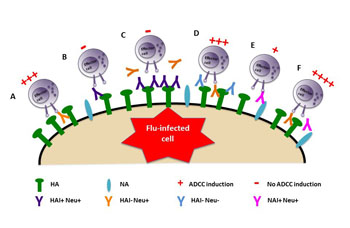Mechanism Described for Cytotoxicity Regulation against Influenza A
By LabMedica International staff writers
Posted on 20 Oct 2016
A new discovery that revealed how neutralizing antibodies bind to specific antigens on the flu virus may aid in the development of a universal influenza vaccine.Posted on 20 Oct 2016
In addition to binding and neutralizing antigens, antibodies are also capable of stimulating cellular responses through Fc–Fc receptor interactions. The fragment crystallizable region (Fc region) is the tail region of an antibody that interacts with cell surface receptors called Fc receptors and some proteins of the complement system. The Fc region of all antibodies in a class is the same for each species; they are constant rather than variable.

Image: Neutralizing antibodies that bind to specific antigens on the flu virus may aid in the development of a universal influenza vaccine (Photo courtesy of Dr. Matthew Miller, McMaster University).
The type of response stimulated by these interactions is influenced by both the Fc receptor type expressed on the effector cell and the isotype of antibody to which it is bound. However, how antibody specificity influences Fc receptor functions, and how antibodies of different specificities interact to modulate these functions, remain unknown.
Investigators at McMaster University (Hamilton, Canada) used influenza A virus as a model to demonstrate that antibody specificity profoundly influenced the induction of antibody-dependent cell-mediated cytotoxicity by effector cells. They reported in October 3, 2016, online edition of the journal Proceedings of the [U.S.] National Academy of Sciences that the generation of strain-specific neutralizing antibodies against influenza A virus was known to confer potent protection against homologous infections. The majority of these antibodies bound to the hemagglutinin (HA) head domain and functioned by blocking the receptor-binding site, preventing infection of host cells.
Elicitation of broadly neutralizing antibodies, which target the viruses' conserved HA stalk domain, has become a promising “universal” influenza virus vaccine strategy. The ability of these antibodies to elicit Fc-dependent effector functions has emerged as an important mechanism through which protection is achieved in vivo. However, the way in which Fc-dependent effector functions are regulated by polyclonal influenza virus-binding antibody mixtures in vivo has never been defined.
In the current study, the investigators demonstrated that interactions among viral glycoprotein-binding antibodies of varying specificities regulated the magnitude of antibody-dependent cell-mediated cytotoxicity induction. They showed that the mechanism responsible for this phenotype relied upon competition for binding to HA on the surface of infected cells and virus particles. Non-neutralizing antibodies were poor inducers and did not inhibit antibody-dependent cell-mediated cytotoxicity.
“Our findings show that just having antibodies is not enough. You have to have antibodies that bind to very specific places on the virus,” said senior author Dr. Matthew Miller, assistant professor of biochemistry and biomedical sciences at McMaster University. “Now that we know the places where antibodies have to bind, we can modify our vaccines so that we generate those antibodies in higher numbers. Using this knowledge, what we can now do is specifically design our universal vaccine to generate the most desirable types of antibodies and avoid antibodies that block the functions that we want. In doing that, we can make sure that the vaccine will work in the most effective way possible.”
Related Links:
McMaster University













